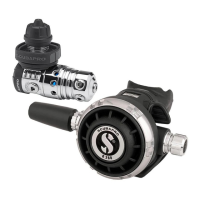14
⚠
WARNING
Breathing must be continuous, without holding one’s breath.
If the second stage is used as an alternate air source (octopus) the V.I.V.A. knob should be
set to the “MIN” or the “PREDIVE” position for the entire duration of the dive. Should the use
of this second stage be needed, the knob must be turned to “MAX” or “DIVE”.
Img. 6
⚠
WARNING
All dives must be planned and carried out so that at the end of the dive the diver will
still have a reasonable reserve of air for emergency use. The suggested amount is
usually 50 bars (725 psi).
7.2 Coldwateruse
⚠
WARNING
Diving in cold waters requires special equipment and techniques. Before attempting
a cold water dive, obtain adequate training from a recognized certication agency.
EN 250: 2014 norm denes “cold waters” as those having a temperature lower than 10°C
(50 °F) and requires that regulators certied for use in such conditions must be tested and
approved to work properly in temperatures of 4°C (39 °F). If the SCUBA equipment is used in
water with a temperature lower than 10 °C (50 °F) it is important to keep in mind the following:
1. Use only regulators certied for use in these conditions. SCUBAPRO regulators certied
for use in cold water in accordance with norm EN 250: 2014 are marked with “EN250A”
2. Remove the protective sleeves from both the ends of the LP hose
3. Prior to the dive keep the regulator in a warm environment before tting your regulator
on the tank.
4. If the regulator is exposed to colder conditions, much lower than 0°C (32°F), set the
V.I.V.A. knob on “MIN” or “PREDIVE”) to avoid the risk of spontaneous and uncontrolled
free-ow.
5. With high air ows the regulator rst stage cools rapidly, therefore avoid high consumption
rates during cold water dives. For example, avoid simultaneously using the buoyancy
compensator and dry suit inator and the alternate air source. It’s also advised to avoid
checking the second stage function via the purge button, unless absolutely necessary.
Ensure that the cylinder is lled only with air compliant with norm EN 12021.

